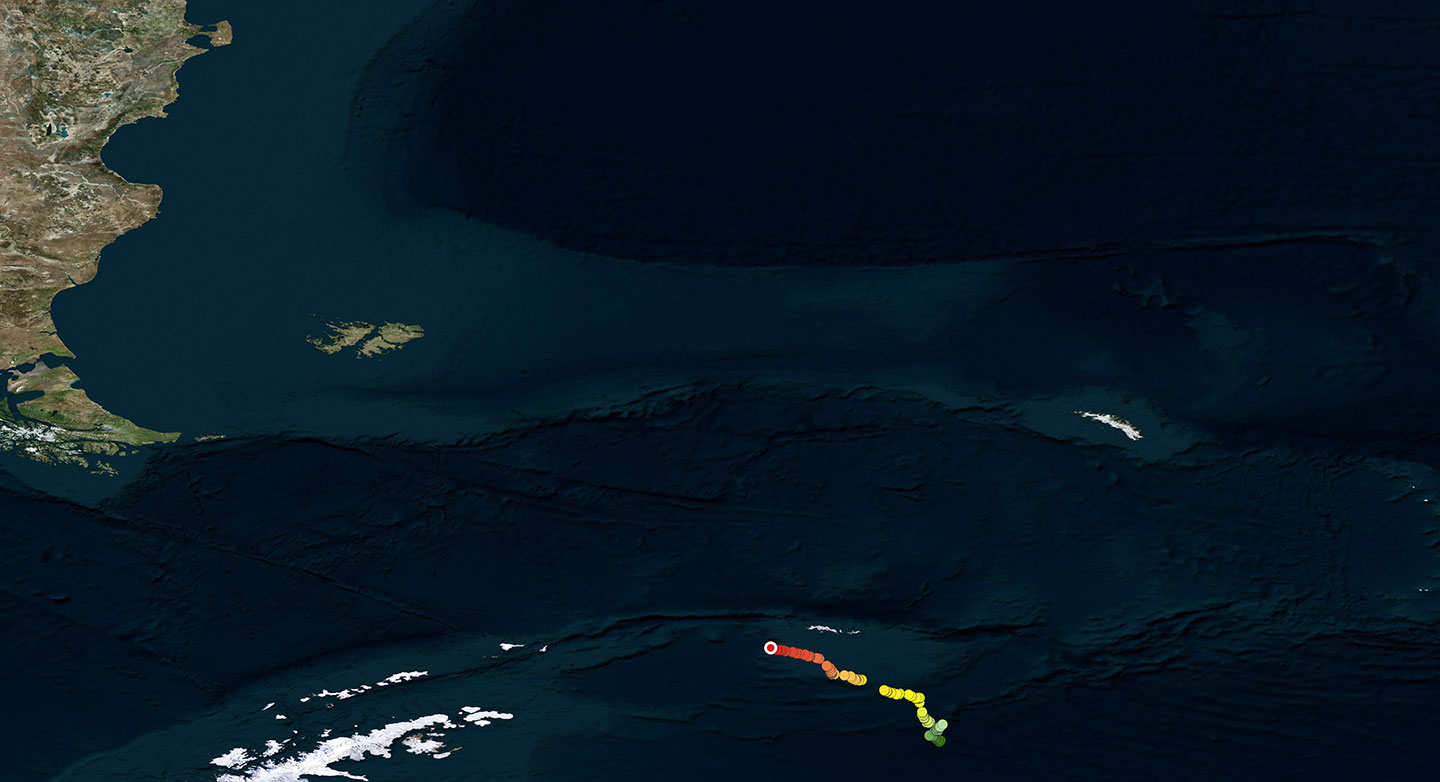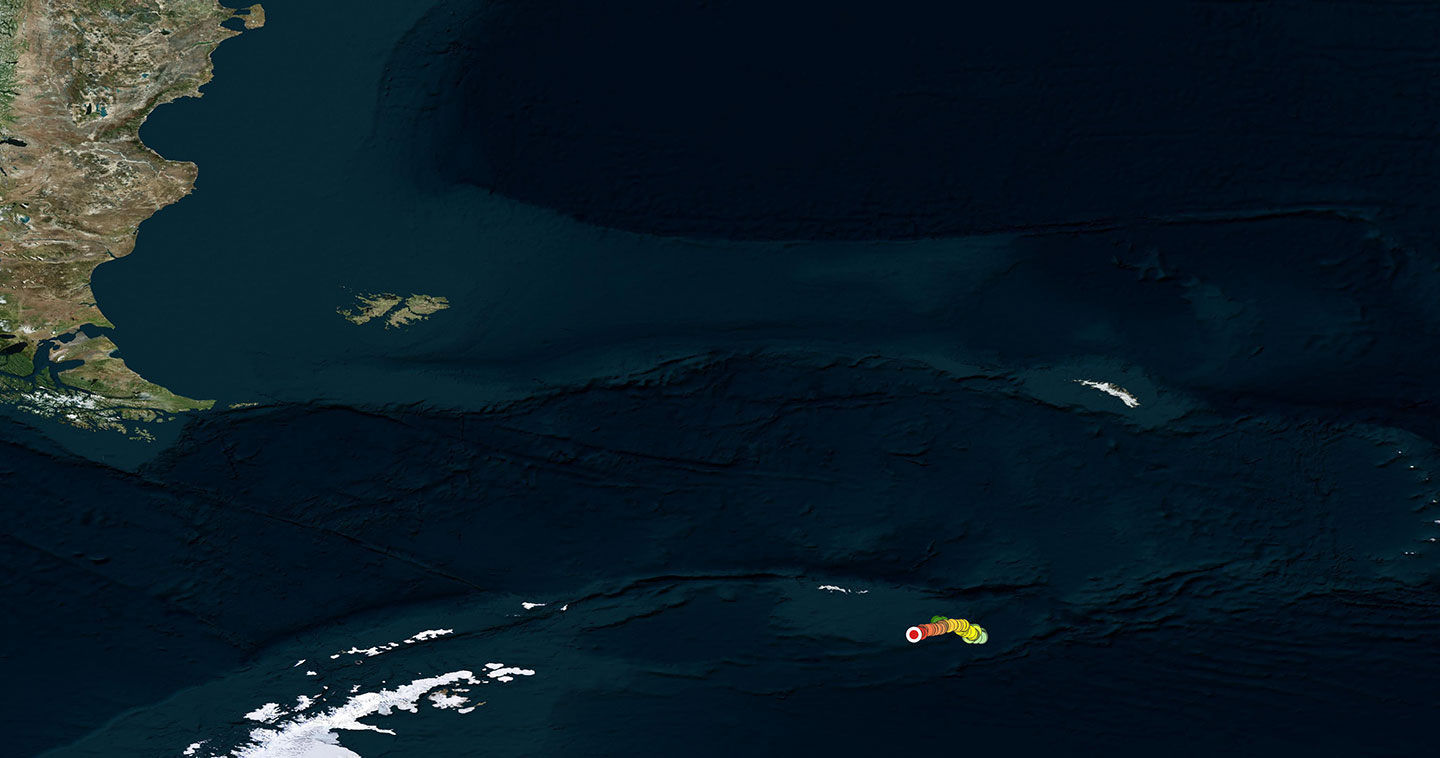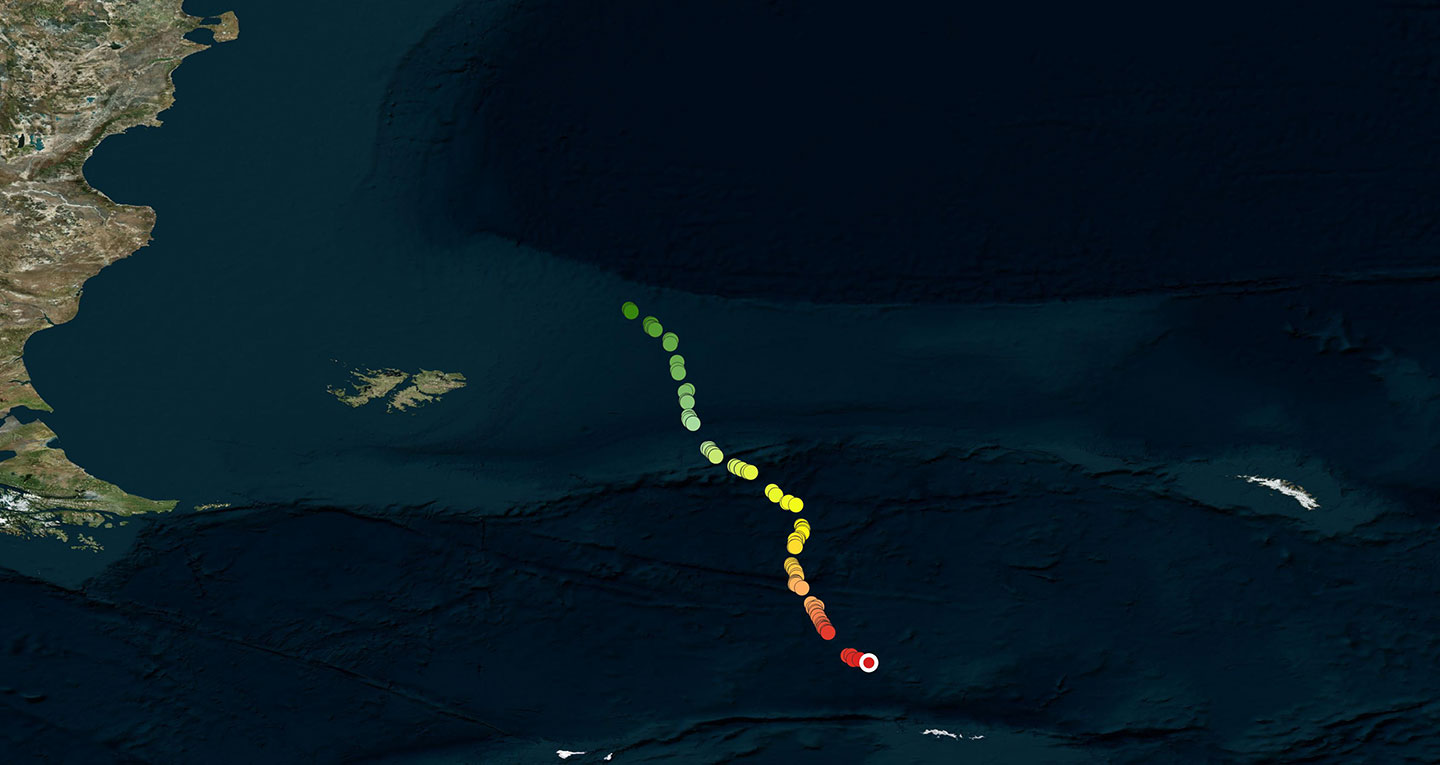Photo: M. Uhart
Misterio’s 200 day tracking route (18,860 km)

March 31 – April 01, 2020
After being tracked for 200 days, Misterio’s satellite tag stopped transmitting, while he was feeding between the continent and the Malvinas (Falkland) Islands. This juvenile traveled more than 16,000 kilometers from Golfo Nuevo northwards to the Río de la Plata (River Plate) and Uruguayan waters, followed by a southward trip all the way to the Weddell Sea at latitude 65° S. When we lost contact a few days ago Misterio had begun the trip back to the Peninsula Valdés, this time choosing a route west of the Malvinas (Falkland) archipelago.

March 24 – March 30, 2020
During this week Misterio traveled along the northern edge of the submerged plateau of the Namuncurá-Burdwood Bank area (declared a Marine Protected Area in 2013 by the Argentine government), to a section of the continental shelf between the Malvinas (Falkland) Islands and the Province of Santa Cruz. This region was also explored by “69”, Metido and Afuerita.

March 17 – March 23, 2020
Misterio traveled from the Scotia Sea to the shallow waters of the continental shelf southeast of the Namuncurá – Burdwood Bank Marine Protected Area. Here sea floor topography and circumpolar current dynamics cause the division of waters: the main current branch, flowing from south to north, is the cold Malvinas (Falkland) Current which influences the entire Patagonian marine ecosystem.

March 11 – March 16, 2020
Misterio, a solitary individual, seems to have finished its stay in the frigid Antarctic waters this week and has traveled northwest hundreds of kilometers, most likely to a known destination: the Argentine continental shelf.

March 04 – March 10, 2020
After feeding for a few days in the deep waters of the Weddell Sea, Misterio began traveling northwestward. Misterio is now 90 kilometers from the South Orkney Islands.

February 25 – March 03, 2020
Misterio began swimming southeast in the deep, cold waters of the Weddell Sea to latitude 64° S, then changed direction to the northwest and slowed down, which indicates this solitary individual has found food.

February 19 – February 24, 2020
Misterio suddenly changed direction by 180º after seeming to be following the Scotia Arc east of the South Orkneys. This solitary individual has now reached the area where Fiesta is feeding.

February 11 – February 18, 2020
Misterio passed through the Scotia Arc and remains in an area southeast of the South Orkney Islands. It is possible that this solitary individual has found high concentrations of krill in this sub-Antarctic region. Krill is a key food species for many birds and marine mammals which feed in this area.

February 07 – February 10, 2020
Misterio traveled southeast reaching the Scotia Arc (Arco de las Antillas Australes). He passed through the Lewthwaite Strait while exploring the coasts of the South Orkney Islands.

January 29 – February 06, 2020
As if following the route Fiesta took a few weeks ago, Misterio continues trailing south. After covering 1,150 kilometers in 10 days, he is currently about 200 kilometers from the South Orkney Islands.

January 21 – January 28, 2020
Misterio swam 630 kilometers southeast this week, mimicking almost exactly the route Fiesta traveled more than 15 days ago. Could it be that this whale who was in Uruguayan waters last November has now decided to head to the sub-Antarctic ocean?

January 12 – January 20, 2020
After his adventurous travels northwards which took him to the mouth of the Río de la Plata (River Plate), Misterio has begun traveling south. In the past week he crossed the continental slope and reached the deep South Atlantic Ocean Basin.

January 06 – January 11, 2020
For the last three weeks Misterio has continued exploring a 12,000 square kilometers area of the continental shelf.

December 29, 2019 – January 05, 2020
Misterio has remained in the same area of high productivity he was in the week before, on the continental shelf at the latitude of the south of Buenos Aires province.

December 22 – December 28, 2019
Misterio continued in the same area, scarcely moving from west to east at the latitude of Bahia San Blas. Chlorophyll concentration maps continue to show high levels of chlorophyll in this area of the continental shelf, so it is possible that he will remain here more time feeding.

December 16 – December 21, 2019
Misterio continues on his trip southwards. After swimming a few days to the west, he took up a course almost parallel to the edge of the continental shelf. By superimposing maps of chlorophyll concentrations with his movements, it could be seen that Misterio changed his direction towards an area of high productivity. With abundant food available it is possible that he will remain in this area for some time.

December 05 – December 15, 2019
Misterio was traveling towards the southeast, but then turned 180 degrees to return to a place he had previously explored on the edge of the continental shelf. He remained there for six days, probably feeding. He is now swimming southwards next to the continental slope.

November 26 – December 04, 2019
This individual continues traveling to the southwest after remaining 45 days in the area of the mouth of the Rio de la Plata and the continental slope. His last transmission was about 100 kilometers away from the city of Mar del Plata.

November 17 – November 25, 2019
Misterio began swimming slowly towards the southeast, leaving behind Uruguay, and traveling parallel to the continental slope. He has traveled 166 kilometers in the last 10 days.

November 10 – November 16, 2019
Misterio remains in the zone of the continental shelf, in Uruguyan waters. The conservation of the southern right whale, as of other species whose migrations take them through waters of different political jurisdictions, requires the coordinated effort and teamwork of the various countries involved.

November 2 – November 9, 2019
This juvenile continues in front of the mouth of the Río de la Plata (River Plate), very close to the continental slope, the limit of the continental shelf, where depths pass from hundreds to thousands of meters. This area, within the Brazilian current, also receives nutrients from both the Uruguay and Parana rivers. The abundance of zooplankton is surely the reason for Misterio’s prolonged presence in this area.

October 27 – November 1, 2019
Misterio continues moving slowly northwards, in front of the Río de la Plata (River Plate). Today he is in Uruguayan waters about 120 kilometers from Punta del Este.

October 16 – October 26, 2019
Misterio is a juvenile who traveled in a northerly direction, sticking close to the coasts of Río Negro and Buenos Aires provinces. He has remained these last 10 days in front of the mouth of the Río de la Plata (River Plate). He may be feeding in this relatively small area (considering the large areas normally covered by this species).

September 14 – October 15, 2019
Misterio is a juvenile of unknown sex who remained ten days in Glofo Nuevo. He then left the gulf heading north traveling along the coast of Buenos Aires province to the zone of Pinamar. From there he traveled east and northwards on the continental shelf. At this time he is equidistant from Punta Rasa, Argentina and Punta del Este, Uruguay, about 150 kilometers from each coast. This ocean region receives nutrients from the Río de la Plata (River Plate) and it is probable that Misterio is feeding there.
